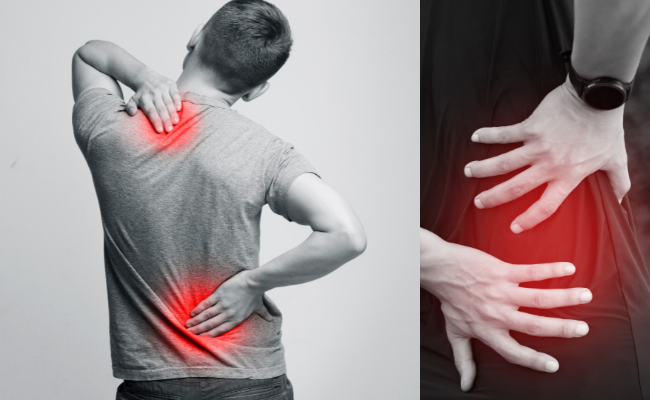How to Treat Body Pain?
- November 09, 2023
- No Comments

What is Body Pain?
Body pain, also known as musculoskeletal pain, is a common discomfort experienced by individuals of all ages. It can manifest as aching, soreness, stiffness, or even sharp, localized pain in various parts of the body, such as the muscles, joints, and bones. Body pain can be acute, lasting for a short duration, or chronic, persisting over an extended period. This prevalent condition can significantly affect one's quality of life and daily functioning.
Why Does Body Pain Occur?
There are various factors that contribute to the onset of body pain. Understanding the underlying causes can help in effective treatment and prevention. Here are some of the common reasons why body pain occurs:
- Muscle Strain: Overexertion, lifting heavy objects, or engaging in intense physical activities can lead to muscle strains. This can result in localized or widespread muscle pain.
- Joint Problems: Conditions like arthritis, bursitis, or tendinitis can lead to joint pain. Inflammation, wear and tear, or injury to the joints can cause discomfort.
- Injury or Trauma: Accidents, falls, or sports injuries can cause immediate pain in the affected area. Depending on the severity, pain can be short-term or chronic.
- Poor Posture: Maintaining an incorrect posture for extended periods can strain muscles and lead to pain, especially in the neck, back, and shoulders.
- Underlying Medical Conditions: Certain medical conditions, like fibromyalgia, lupus, and multiple sclerosis, can cause chronic body pain as a symptom.
- Stress and Tension: Emotional and psychological stress can manifest physically, leading to muscle tension and discomfort.
How to Treat Body Pain?
Treating body pain depends on its underlying cause and the severity of the pain. There are various approaches to alleviate and manage body pain effectively:
- Rest and Ice: For acute injuries or muscle strains, resting the affected area and applying ice can help reduce inflammation and relieve pain. Ice should be applied for 15-20 minutes every few hours.
- Over-the-counter (OTC) Pain Relievers: Non-prescription pain relievers like ibuprofen or acetaminophen can provide temporary relief from mild to moderate pain. It's essential to follow the recommended dosage and consult a healthcare professional if pain persists.
- Physical Therapy: Physical therapists are experts in assessing and treating musculoskeletal pain. They can create personalized exercise programs to improve strength and flexibility, reducing pain over time.
- Heat Therapy: Applying heat to the affected area, such as using a heating pad or taking a warm bath, can help relax muscles and ease pain. This is particularly useful for chronic conditions like back pain.
- Massage: Therapeutic massage can target specific muscle groups, release tension, and improve blood circulation, which can alleviate pain and promote relaxation.
- Chiropractic Care: Chiropractors focus on the musculoskeletal system, particularly the spine. They use manual adjustments to correct misalignments and relieve pain, especially in cases of back and neck pain.
- Acupuncture: This ancient Chinese practice involves inserting thin needles into specific points on the body to stimulate energy flow and reduce pain. Many individuals find acupuncture effective for managing chronic pain conditions.
- Medication: In cases of severe or chronic pain, healthcare professionals may prescribe stronger pain relievers, muscle relaxants, or medications to manage underlying conditions like arthritis.
- Exercise and Stretching: Regular physical activity, such as low-impact exercises and stretching, can help maintain joint flexibility, strengthen muscles, and prevent future pain.
- Mind-Body Techniques: Techniques like yoga, tai chi, and meditation can help manage pain by reducing stress and promoting relaxation.
Treatment Solutions for Body Pain:
Treating body pain is not a one-size-fits-all approach. The choice of treatment depends on the cause and individual preferences. Here are some treatment solutions for body pain:
- Physical Therapy: This solution is ideal for individuals looking for a structured and evidence-based approach to address their pain. Physical therapists create customized plans and monitor progress, making it an effective choice for rehabilitation and long-term management.
- Medication: Prescribed medications are suitable for those with moderate to severe pain or underlying medical conditions contributing to pain. It's important to follow the doctor's instructions and be aware of potential side effects.
- Alternative Therapies: Acupuncture, chiropractic care, and massage offer non-invasive options for pain relief. These therapies focus on addressing the root causes of pain and improving overall well-being.
- Exercise and Lifestyle Changes: For individuals seeking a proactive approach, incorporating regular exercise and adopting a healthy lifestyle can help prevent and manage pain. It's a holistic solution that promotes overall wellness.
- Mind-Body Techniques: These techniques are suitable for those who want to address not only the physical aspects of pain but also the psychological and emotional components. They offer a well-rounded approach to pain management.
Benefits of Treating Body Pain:
Addressing body pain promptly and effectively offers several benefits:
- Improved Quality of Life: Treating body pain can lead to enhanced mobility and reduced discomfort, allowing individuals to engage in their daily activities with greater ease.
- Prevention of Chronic Conditions: Timely treatment can prevent acute pain from evolving into chronic conditions, improving long-term health outcomes.
- Enhanced Mental Health: Reducing pain can alleviate stress and anxiety, promoting better mental well-being.
- Increased Productivity: Pain-free individuals can perform better at work and in daily tasks, resulting in increased productivity.
- Better Sleep: Pain relief leads to better sleep quality, which is essential for overall health and vitality.
- Reduced Healthcare Costs: Treating pain in its early stages can prevent the need for costly interventions and surgeries in the future.
Comments (0)